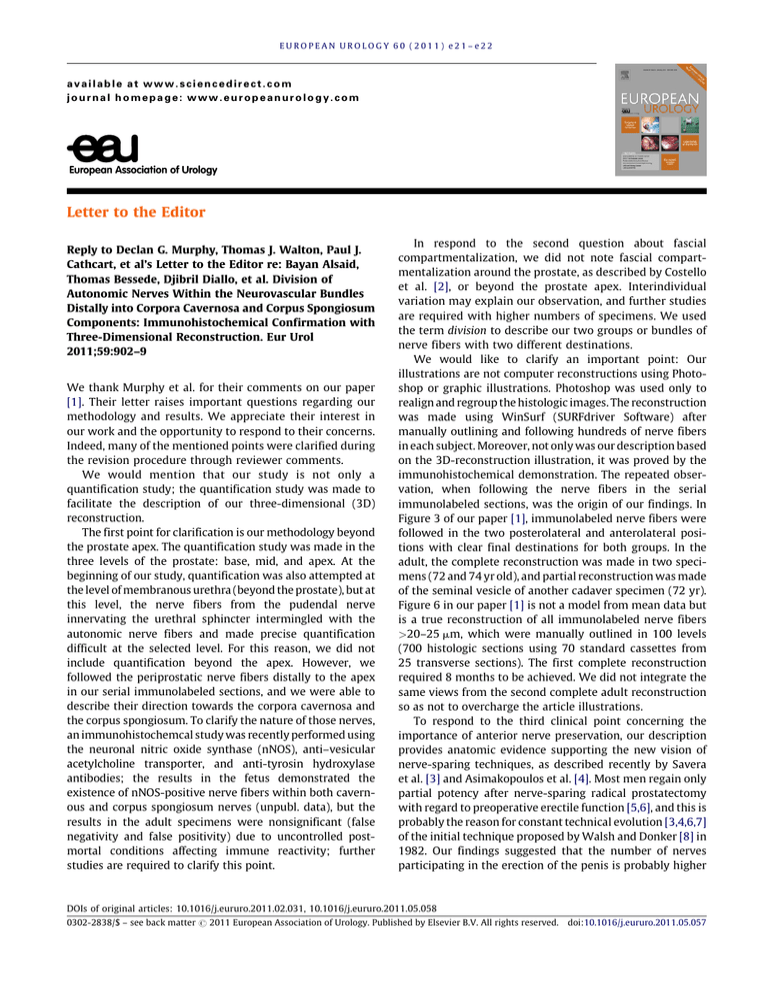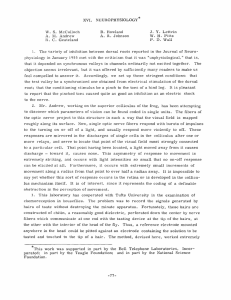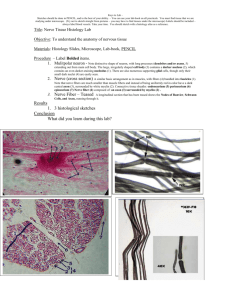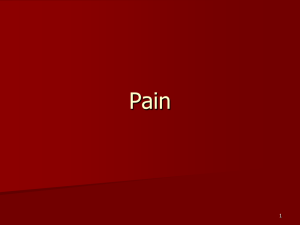
EUROPEAN UROLOGY 60 (2011) e21–e22
available at www.sciencedirect.com
journal homepage: www.europeanurology.com
Letter to the Editor
Reply to Declan G. Murphy, Thomas J. Walton, Paul J.
Cathcart, et al’s Letter to the Editor re: Bayan Alsaid,
Thomas Bessede, Djibril Diallo, et al. Division of
Autonomic Nerves Within the Neurovascular Bundles
Distally into Corpora Cavernosa and Corpus Spongiosum
Components: Immunohistochemical Confirmation with
Three-Dimensional Reconstruction. Eur Urol
2011;59:902–9
We thank Murphy et al. for their comments on our paper
[1]. Their letter raises important questions regarding our
methodology and results. We appreciate their interest in
our work and the opportunity to respond to their concerns.
Indeed, many of the mentioned points were clarified during
the revision procedure through reviewer comments.
We would mention that our study is not only a
quantification study; the quantification study was made to
facilitate the description of our three-dimensional (3D)
reconstruction.
The first point for clarification is our methodology beyond
the prostate apex. The quantification study was made in the
three levels of the prostate: base, mid, and apex. At the
beginning of our study, quantification was also attempted at
the level of membranous urethra (beyond the prostate), but at
this level, the nerve fibers from the pudendal nerve
innervating the urethral sphincter intermingled with the
autonomic nerve fibers and made precise quantification
difficult at the selected level. For this reason, we did not
include quantification beyond the apex. However, we
followed the periprostatic nerve fibers distally to the apex
in our serial immunolabeled sections, and we were able to
describe their direction towards the corpora cavernosa and
the corpus spongiosum. To clarify the nature of those nerves,
an immunohistochemcal study was recently performed using
the neuronal nitric oxide synthase (nNOS), anti–vesicular
acetylcholine transporter, and anti-tyrosin hydroxylase
antibodies; the results in the fetus demonstrated the
existence of nNOS-positive nerve fibers within both cavernous and corpus spongiosum nerves (unpubl. data), but the
results in the adult specimens were nonsignificant (false
negativity and false positivity) due to uncontrolled postmortal conditions affecting immune reactivity; further
studies are required to clarify this point.
In respond to the second question about fascial
compartmentalization, we did not note fascial compartmentalization around the prostate, as described by Costello
et al. [2], or beyond the prostate apex. Interindividual
variation may explain our observation, and further studies
are required with higher numbers of specimens. We used
the term division to describe our two groups or bundles of
nerve fibers with two different destinations.
We would like to clarify an important point: Our
illustrations are not computer reconstructions using Photoshop or graphic illustrations. Photoshop was used only to
realign and regroup the histologic images. The reconstruction
was made using WinSurf (SURFdriver Software) after
manually outlining and following hundreds of nerve fibers
in each subject. Moreover, not only was our description based
on the 3D-reconstruction illustration, it was proved by the
immunohistochemical demonstration. The repeated observation, when following the nerve fibers in the serial
immunolabeled sections, was the origin of our findings. In
Figure 3 of our paper [1], immunolabeled nerve fibers were
followed in the two posterolateral and anterolateral positions with clear final destinations for both groups. In the
adult, the complete reconstruction was made in two specimens (72 and 74 yr old), and partial reconstruction was made
of the seminal vesicle of another cadaver specimen (72 yr).
Figure 6 in our paper [1] is not a model from mean data but
is a true reconstruction of all immunolabeled nerve fibers
>20–25 mm, which were manually outlined in 100 levels
(700 histologic sections using 70 standard cassettes from
25 transverse sections). The first complete reconstruction
required 8 months to be achieved. We did not integrate the
same views from the second complete adult reconstruction
so as not to overcharge the article illustrations.
To respond to the third clinical point concerning the
importance of anterior nerve preservation, our description
provides anatomic evidence supporting the new vision of
nerve-sparing techniques, as described recently by Savera
et al. [3] and Asimakopoulos et al. [4]. Most men regain only
partial potency after nerve-sparing radical prostatectomy
with regard to preoperative erectile function [5,6], and this is
probably the reason for constant technical evolution [3,4,6,7]
of the initial technique proposed by Walsh and Donker [8] in
1982. Our findings suggested that the number of nerves
participating in the erection of the penis is probably higher
DOIs of original articles: 10.1016/j.eururo.2011.02.031, 10.1016/j.eururo.2011.05.058
0302-2838/$ – see back matter # 2011 European Association of Urology. Published by Elsevier B.V. All rights reserved.
doi:10.1016/j.eururo.2011.05.057
e22
EUROPEAN UROLOGY 60 (2011) e21–e22
and that their distribution and nature are more complex than
previously thought, explaining why not all men recover their
preoperative erectile function, despite a well-done nervesparing technique.
Conflicts of interest: The authors have nothing to disclose.
[6] Nielsen ME, Schaeffer EM, Marschke P, Walsh PC. High anterior
release of the levator fascia improves sexual function following
open radical retropubic prostatectomy. J Urol 2008;180:2557–64,
discussion 2564.
[7] Lunacek A, Schwentner C, Fritsch H, Bartsch G, Strasser H. Anatomical radical retropubic prostatectomy: ‘curtain dissection’ of the
neurovascular bundle. BJU Int 2005;95:1226–31.
[8] Walsh PC, Donker PJ. Impotence following radical prostatectomy:
insight into etiology and prevention. J Urol 1982;128:492–7.
References
[1] Alsaid B, Bessede T, Diallo D, et al. Division of autonomic nerves within
Bayan Alsaid*
Thomas Bessede
the neurovascular bundles distally into corpora cavernosa and corpus
Djibril Diallo
spongiosum components: immunohistochemical confirmation with
David Moszkowicz
three-dimensional reconstruction. Eur Urol 2011;59:902–9.
Ibrahim Karam
[2] Costello AJ, Dowdle BW, Namdarian B, Pedersen J, Murphy DG.
Gérard Benoı̂t
Immunohistochemical study of the cavernous nerves in the peri-
Stéphane Droupy
prostatic region. BJU Int 2011;107:1210–5.
[3] Savera AT, Kaul S, Badani K, et al. Robotic radical prostatectomy with
Laboratory of Experimental Surgery, EA4122, Faculty of Medicine,
University of Paris-Sud 11, Le Kremlin-Bicêtre, France
the ‘‘Veil of Aphrodite’’ technique: histologic evidence of enhanced
nerve sparing. Eur Urol 2006;49:1065–74, discussion 1073–4.
*Corresponding author. Laboratoire de chirurgie expérimentale,
[4] Asimakopoulos AD, Annino F, D’Orazio A, et al. Complete peripros-
EA4122, Faculté de Médecine, Université Paris-Sud,
tatic anatomy preservation during robot-assisted laparoscopic rad-
63 Rue Gabriel Péri, Le Kremlin Bicêtre, 94270 France
ical prostatectomy (RALP): the new pubovesical complex-sparing
E-mail address: drbayan@gmail.com
technique. Eur Urol 2010;58:407–17.
(B. Alsaid)
[5] Audouin M, Beley S, Cour F, et al. Erectile dysfunction after radical
prostatectomy: pathophysiology, evaluation and treatment [article
in French]. Prog Urol 2010;20:172–82.
May 31, 2011
Published online on June 12, 2011






